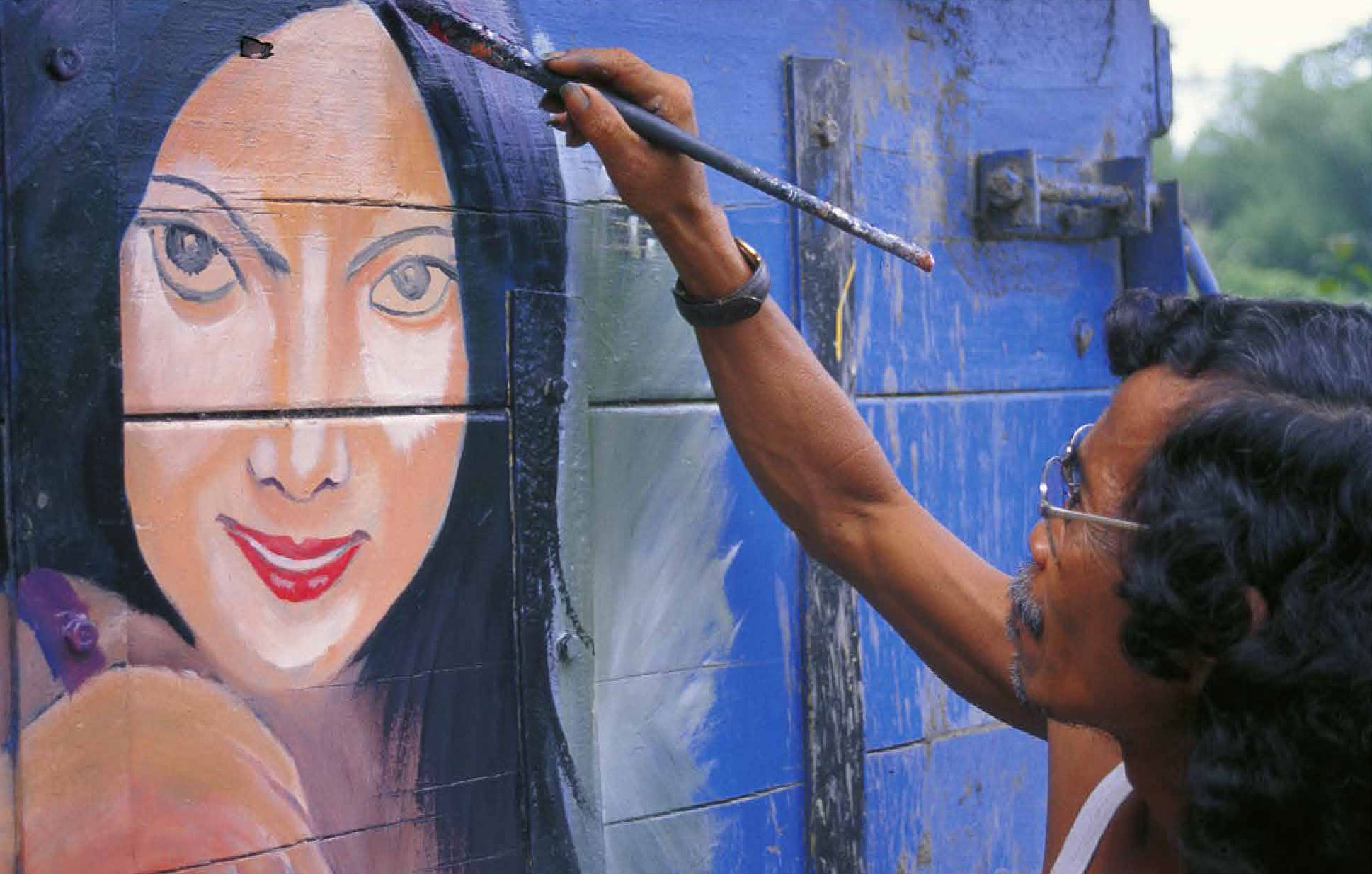
AS BODIES JOLT AND NERVES JANGLE through rush-hour traffic, commuters may see an exploding volcano, a famous family of cartoon ducks traipsing through a rice field, or Britney Spears gazing glassily at equally glazed passengers. For those not so inclined to the secular, a winged steed, or bouraq, ridden by Prophet Mohammed flits by occasionally.
Come face to face with “art on wheels” before it literally wheels out of sight, but hopefully not out of mind. Commanded by valiant warriors of the road, vibrant “artmobiles” rule the baking-hot bands of bitumen lining routes in Indonesia, the Philippines, India and Pakistan.
In the languages of these countries, these vehicles are “rajas”, or kings of the road – ornamented, painted, adorned with all manner of imagery, calligraphy and sometimes paraphernalia – plastic flowers, doors or beads. For the record, these “rajas” have clout – they are the major means of transport, from breakfast staples of noodles or coffee to your nearest and dearest.

INDONESIA: JAGA JARAK (KEEP YOUR DISTANCE)
Painted in cool hues on the back panel of a truck mired in inland traffic, a clipper ship with billowing sails coasts upon calm waters. Driver Adi has never seen the sea before nor a sailing ship. But as he simply says, “It’s nice… I like it.”
Benny’s truck, on the other hand, sports a startling orange orang-utan labelled a “victim of reform”. Who’s the victim – the animal or whom it represents? Road warriors like Adi and Benny pay a hefty price with little time to spare for family and friends. Small wonder then that trucks become second homes, their ornamentation a reflection of individual psyches, emotions or a mirror of social and other conditions.
Who are their executors? Truck painter Haryanto provides the impetus by first sketching customer Rahman’s proposed design, transferring it to the vehicle. If money is no object, the superstructure’s side, back and rear panels are painted, and lacquered thereafter. Rahman’s dreams become reality in the space of a few days to the tune of perhaps IDR2,000,000 (US$200). This raja hits the road blazing red, black and white, an Indonesian-style Batman, tagged Mister Malam; Haryanto’s handiwork is a portable advertisement in itself.

Ranging from traditional puppet characters known as wayang and national icons such as singer-songwriter Iwan Fals, Indonesian truck paintings know few boundaries. Princess Di is still venerated. Then there’s sport and entertainment: Zidane the footballer or Clint Eastwood, naturally spouting “a few dollars more”. Not surprisingly, images of women abound, depicted as buxom beauties or “papayas”, mother figures or religious icons.
Indonesia, a land of beauty and diversity, may be defined regionally by its trucks. Since agriculture is the backbone of Central Java (think rice, potatoes and cabbages), trucks from the region often depict farmers attending to fields, farming couples and produce often accompanied by understated Javanese expressions. West Javan trucks will feature misty mountain landscapes, waterfalls and forests, together with Sundanese phrases, in deference to the area’s volcanic highland territory.

With such eclectic artwork barrelling down the asphalt, an Indonesian-style traffic jam, known as macet, may be an involuntary cultural “classroom”. And as the Indonesian national motto proclaims, “unity in diversity”, the rajas of the road promote national unity (and smiles) by their diverse and rich cultural contributions.
INDIA: HORN OK PLEASE
Few countries and civilizations have so consistently celebrated and practiced the decorative arts and the embellishment and ornamentation of the surface, as India… Spreading along the trade and pilgrimage routes, it has provided an essential unifying factor in such a disparate land…
– Henry Wilson in Pattern and Ornament in the Arts of India (Thames & Hudson, 2011)
This gentle reminder is icing on the cake, the final touch to a confection oozing culture, creativity and colour – the Indian lorry!
As Sanjay will tell you, the Indian lorry is a true raja of the road. The Indian or Malay word raja is of Sanskrit origin commonly used in parts of Asia to denote a monarch.

Sanjay’s lorry, although an ancient Bedford, is lofty because of its “crown” above the driver’s cabin, which is not just for decoration, but to slow it down and secure cargo. Enter Ravi, painter of mobile art, operating out of a small roadside stand. A raja must be properly attired before setting off on a journey.
Although its subject may be as unbridled as man’s fertile imagination, the rear panel’s “big picture” generally revolves around lush countryside peppered with pot-laden village lasses, benign cows and the usual “rural” accessories – as “home” as drivers can get. More dramatic are the depictions of battles involving gods and goddesses of the Indian pantheon. Proud and patriotic gestures feature too: the Taj Mahal, politicians and party leaders have their share of lorry glory. And don’t forget Princess Di! Exuberance coats every square inch of lorry surface, quite comparable to the extent of decoration found in a shopfront or on signage.
Hindu protective religious symbols are never omitted, the auspicious lotus flower known as kamal and the swastika emblem. Naturally, the holy cow features prominently, with mango leaves and coconuts for good measure. To be sure, there’s room for a drawing of an Indian shoe with upturned toe or even a real one hanging from the bumper. Better to be safe than sorry – a horseshoe (the colonial influence) could be added too!
Interestingly, comments, whether social or political, rank at the bottom. For those who read Hindi, there is an overabundance of pithy slogans ranging from “Mothers reign supreme” to “You will get nothing more than you are destined to get and nothing before you are destined to get it”.
English, legacy of the Raj, is alive and well – especially “lorry English”. “Wait For Side” (meaning “wait to pass”) or “Trust In God” relieves the boredom in a traffic jam. Besides the gentle reminder, “Horn Please”, there’s also “Horn OK Please”. Some say “OK” refers to “On Kerosene” – the highly flammable fuel on which Indian trucks once ran – so it’s a good idea to sound the horn before attempting to pass.
Whatever the message, a passage in India is a passage through life. As a lorry from Cochin proclaimed, “Love, Not Anger (Can Save The World)”!
Read the rest of this article in No.98 Issue 5/2013 of Asian Geographic magazine by subscribing here or check out all of our publications here.










